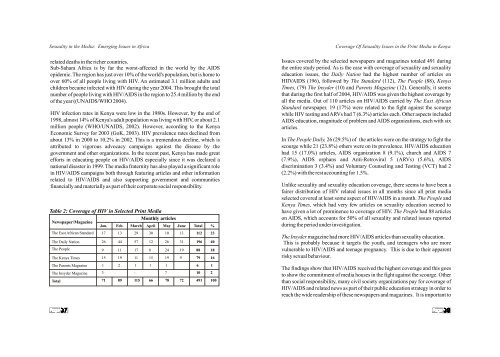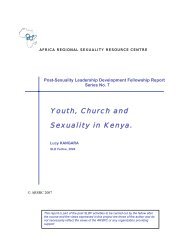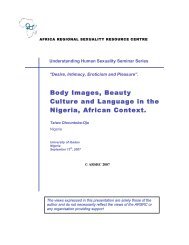Sexuality in Media: Emerging Issues in Africa - Africa Regional ...
Sexuality in Media: Emerging Issues in Africa - Africa Regional ...
Sexuality in Media: Emerging Issues in Africa - Africa Regional ...
Create successful ePaper yourself
Turn your PDF publications into a flip-book with our unique Google optimized e-Paper software.
<strong>Sexuality</strong> <strong>in</strong> the <strong>Media</strong>: Emerg<strong>in</strong>g <strong>Issues</strong> <strong>in</strong> <strong>Africa</strong><br />
related deaths <strong>in</strong> the richer countries.<br />
Sub-Sahara <strong>Africa</strong> is by far the worst-affected <strong>in</strong> the world by the AIDS<br />
epidemic. The region has just over 10% of the world's population, but is home to<br />
over 60% of all people liv<strong>in</strong>g with HIV. An estimated 3.1 million adults and<br />
children became <strong>in</strong>fected with HIV dur<strong>in</strong>g the year 2004. This brought the total<br />
number of people liv<strong>in</strong>g with HIV/AIDS <strong>in</strong> the region to 25.4 million by the end<br />
of the year ((UNAIDS/WHO 2004).<br />
HIV <strong>in</strong>fection rates <strong>in</strong> Kenya were low <strong>in</strong> the 1980s. However, by the end of<br />
1998, almost 14% of Kenya's adult population was liv<strong>in</strong>g with HIV, or about 2.1<br />
million people (WHO/UNAIDS, 2002). However, accord<strong>in</strong>g to the Kenya<br />
Economic Survey for 2003 (GoK, 2003). HIV prevalence rates decl<strong>in</strong>ed from<br />
about 13% <strong>in</strong> 2000 to 10.2% <strong>in</strong> 2002. This is a tremendous decl<strong>in</strong>e, which is<br />
attributed to vigorous advocacy campaigns aga<strong>in</strong>st the disease by the<br />
government and other organizations. In the recent past, Kenya has made great<br />
efforts <strong>in</strong> educat<strong>in</strong>g people on HIV/AIDS especially s<strong>in</strong>ce it was declared a<br />
national disaster <strong>in</strong> 1999. The media fraternity has also played a significant role<br />
<strong>in</strong> HIV/AIDS campaigns both through featur<strong>in</strong>g articles and other <strong>in</strong>formation<br />
related to HIV/AIDS and also support<strong>in</strong>g government and communities<br />
f<strong>in</strong>ancially and materially as part of their corporate social responsibility.<br />
Table 2: Coverage of HIV <strong>in</strong> Selected Pr<strong>in</strong>t <strong>Media</strong><br />
Newspaper/Magaz<strong>in</strong>e<br />
Jan. Feb.<br />
Monthly articles<br />
March April May June Total %<br />
The East <strong>Africa</strong>n Standard<br />
The Daily Nation<br />
The People<br />
The Kenya Times<br />
The Parents Magaz<strong>in</strong>e<br />
The Insyder Magaz<strong>in</strong>e<br />
Total<br />
17 13 29 30 10 13 112 23<br />
26 44 57 12 26 31 196 40<br />
9 11 17 8 24 19 88 18<br />
15 19 11 15 19 9 79 16<br />
1 2 1 1 1 6 1<br />
3 - 7 10 2<br />
71 89 115 66 78 72 491 100<br />
Coverage Of <strong>Sexuality</strong> <strong>Issues</strong> <strong>in</strong> the Pr<strong>in</strong>t <strong>Media</strong> <strong>in</strong> Kenya<br />
<strong>Issues</strong> covered by the selected newspapers and magaz<strong>in</strong>es totaled 491 dur<strong>in</strong>g<br />
the entire study period. As is the case with coverage of sexuality and sexuality<br />
education issues, the Daily Nation had the highest number of articles on<br />
HIIVAIDS (196), followed by The Standard (112), The People (88), Kenya<br />
Times, (79) The Insyder (10) and Parents Magaz<strong>in</strong>e (12). Generally, it seems<br />
that dur<strong>in</strong>g the first half of 2004, HIV/AIDS was given the highest coverage by<br />
all the media. Out of 110 articles on HIV/AIDS carried by The East <strong>Africa</strong>n<br />
Standard newspaper, 19 (17%) were related to the fight aga<strong>in</strong>st the scourge<br />
while HIV test<strong>in</strong>g and ARVs had 7 (6.3%) articles each. Other aspects <strong>in</strong>cluded<br />
AIDS education, magnitude of problem and AIDS organizations, each with six<br />
articles.<br />
In The People Daily, 26 (29.5%) of the articles were on the strategy to fight the<br />
scourge while 21 (23.8%) others were on its prevalence. HIV/AIDS education<br />
had 15 (17.0%) articles, AIDS organization 8 (9.1%), church and AIDS 7<br />
(7.9%), AIDS orphans and Anti-Retroviral 5 (ARVs) (5.6%), AIDS<br />
discrim<strong>in</strong>ation 3 (3.4%) and Voluntary Counsel<strong>in</strong>g and Test<strong>in</strong>g (VCT) had 2<br />
(2.2%) with the rest account<strong>in</strong>g for 1.5%.<br />
Unlike sexuality and sexuality education coverage, there seems to have been a<br />
fairer distribution of HIV related issues <strong>in</strong> all months s<strong>in</strong>ce all pr<strong>in</strong>t media<br />
selected covered at least some aspect of HIV/AIDS <strong>in</strong> a month. The People and<br />
Kenya Times, which had very few articles on sexuality education seemed to<br />
have given a lot of prom<strong>in</strong>ence to coverage of HIV. The People had 88 articles<br />
on AIDS, which accounts for 50% of all sexuality and related issues reported<br />
dur<strong>in</strong>g the period under <strong>in</strong>vestigation.<br />
The Insyder magaz<strong>in</strong>e had more HIV/AIDS articles than sexuality education.<br />
This is probably because it targets the youth, and teenagers who are more<br />
vulnerable to HIV/AIDS and teenage pregnancy. This is due to their apparent<br />
risky sexual behaviour.<br />
The f<strong>in</strong>d<strong>in</strong>gs show that HIV/AIDS received the highest coverage and this goes<br />
to show the commitment of media houses <strong>in</strong> the fight aga<strong>in</strong>st the scourge. Other<br />
than social responsibility, many civil society organizations pay for coverage of<br />
HIV/AIDS and related news as part of their public education strategy <strong>in</strong> order to<br />
reach the wide readership of these newspapers and magaz<strong>in</strong>es. It is important to






